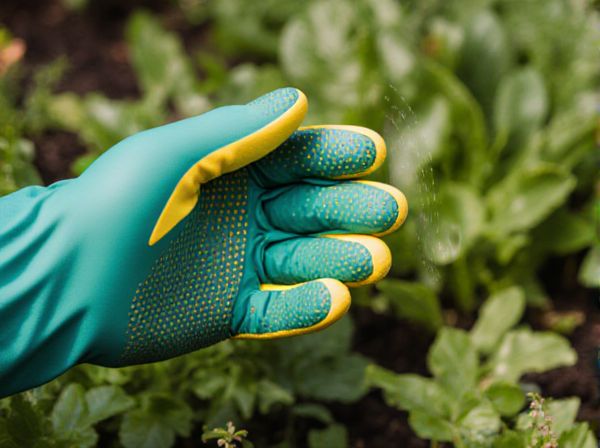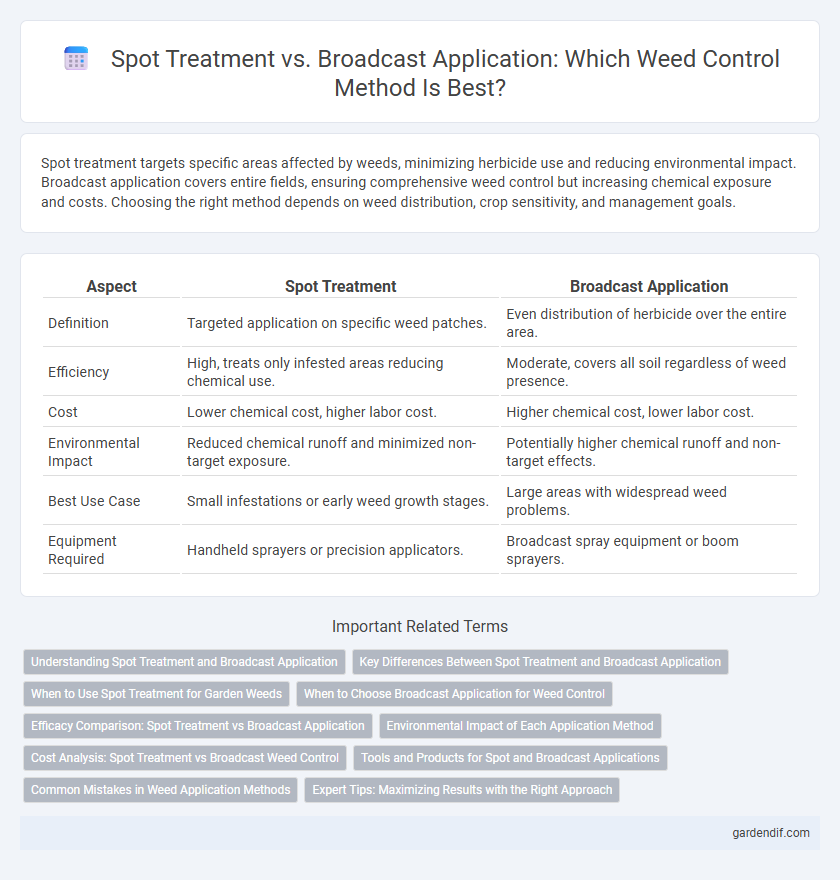
Spot Treatment vs Broadcast Application Illustration
Spot treatment targets specific areas affected by weeds, minimizing herbicide use and reducing environmental impact. Broadcast application covers entire fields, ensuring comprehensive weed control but increasing chemical exposure and costs. Choosing the right method depends on weed distribution, crop sensitivity, and management goals.
Table of Comparison
| Aspect | Spot Treatment | Broadcast Application |
|---|---|---|
| Definition | Targeted application on specific weed patches. | Even distribution of herbicide over the entire area. |
| Efficiency | High, treats only infested areas reducing chemical use. | Moderate, covers all soil regardless of weed presence. |
| Cost | Lower chemical cost, higher labor cost. | Higher chemical cost, lower labor cost. |
| Environmental Impact | Reduced chemical runoff and minimized non-target exposure. | Potentially higher chemical runoff and non-target effects. |
| Best Use Case | Small infestations or early weed growth stages. | Large areas with widespread weed problems. |
| Equipment Required | Handheld sprayers or precision applicators. | Broadcast spray equipment or boom sprayers. |
Understanding Spot Treatment and Broadcast Application
Spot treatment targets specific weed patches with precise herbicide application, minimizing chemical use and reducing environmental impact. Broadcast application involves evenly spreading herbicides over an entire area, providing comprehensive weed control but often requiring higher chemical volumes. Choosing between these methods depends on weed infestation patterns and management goals for effective and sustainable weed control.
Key Differences Between Spot Treatment and Broadcast Application
Spot treatment targets specific weed infestations, applying herbicides directly to affected areas, reducing chemical use and minimizing environmental impact. Broadcast application involves spreading herbicides uniformly across an entire field or lawn, ensuring comprehensive weed control but increasing the risk of herbicide resistance and non-target damage. Choice between the two depends on infestation extent, cost, and desired environmental outcomes.
When to Use Spot Treatment for Garden Weeds
Spot treatment is most effective for isolated weed patches or early infestations, minimizing herbicide use and protecting desirable plants. This targeted method allows precise application on specific weed species, reducing environmental impact and herbicide resistance risks. Gardeners should employ spot treatment when weeds are sparse, ensuring efficient control without widespread chemical exposure.
When to Choose Broadcast Application for Weed Control
Broadcast application for weed control is ideal when dealing with widespread or heavy weed infestations across large areas, as it evenly distributes herbicides to maximize coverage and effectiveness. It is particularly useful in agricultural fields, lawns, or pastures where uniform weed suppression is critical to prevent competition with crops or desirable plants. Choosing broadcast application ensures rapid, comprehensive control, reducing the risk of weed resistance and promoting healthier plant growth.
Efficacy Comparison: Spot Treatment vs Broadcast Application
Spot treatment delivers targeted herbicide application, maximizing efficacy by concentrating chemicals directly on weed clusters, which minimizes herbicide use and reduces environmental impact. Broadcast application covers the entire area uniformly, ensuring comprehensive weed control but often requires higher chemical volumes and may affect non-target plants. Studies indicate spot treatment achieves superior control in localized infestations, while broadcast is more effective for widespread or dense weed populations.
Environmental Impact of Each Application Method
Spot treatment minimizes environmental impact by targeting specific weed areas, reducing the amount of herbicide released into soil and water systems. Broadcast application disperses chemicals over a wide area, increasing the risk of runoff and non-target plant exposure, potentially harming biodiversity and aquatic ecosystems. Choosing spot treatment supports sustainable weed management by lowering chemical use and preserving surrounding vegetation and wildlife habitats.
Cost Analysis: Spot Treatment vs Broadcast Weed Control
Spot treatment for weed control targets specific infested areas, significantly reducing herbicide volume and lowering overall costs compared to broadcast application, which applies chemicals uniformly across the entire field. Broadcast application requires higher quantities of herbicides, increasing expenses related to product purchase, labor, and environmental management. Cost analysis reveals that spot treatment offers a more economical and environmentally sustainable approach, especially for fields with low weed density or patchy infestations.
Tools and Products for Spot and Broadcast Applications
Spot treatment tools include handheld sprayers, trigger spray bottles, and wands designed for precise application of herbicides on individual weeds, minimizing chemical use and environmental impact. Broadcast applications utilize larger equipment such as backpack sprayers, boom sprayers, and tractor-mounted applicators to evenly distribute herbicides over wide areas, ensuring comprehensive weed control in lawns or agricultural fields. Popular products for spot treatment often feature systemic herbicides like glyphosate in low-volume formulations, while broadcast products commonly use pre-emergent and post-emergent herbicides suitable for large-scale coverage.
Common Mistakes in Weed Application Methods
Common mistakes in weed application methods often stem from improper selection between spot treatment and broadcast application. Overusing broadcast applications can lead to herbicide resistance and environmental contamination, while inadequate coverage in spot treatments results in ineffective weed control. Failure to calibrate equipment accurately and ignoring weed growth stages further reduces application efficacy and increases management costs.
Expert Tips: Maximizing Results with the Right Approach
Spot treatment targets specific weed infestations with concentrated herbicides, reducing chemical use and minimizing environmental impact. Broadcast application covers entire areas uniformly, effective for widespread weed problems but may increase product consumption and risk of resistance. Experts recommend assessing weed distribution and growth stage to select the approach, ensuring precision and optimal herbicide effectiveness for sustainable weed management.
Spot Treatment vs Broadcast Application Infographic

 gardendif.com
gardendif.com